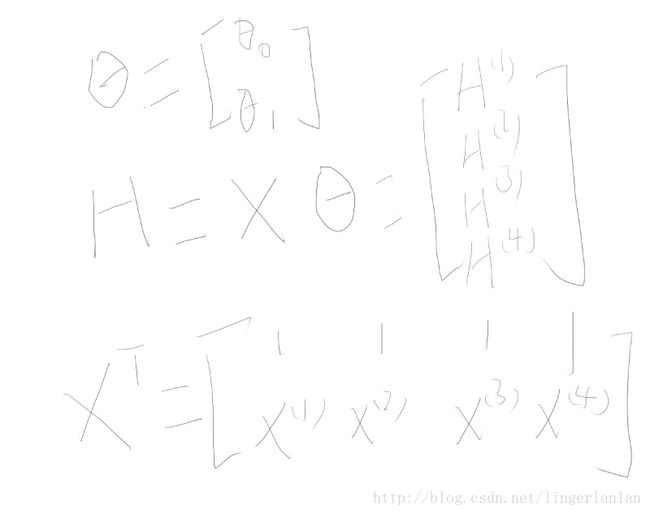从零单排入门机器学习:线性回归(linear regression)实践篇
线性回归(linear regression)实践篇
之前一段时间在coursera看了Andrew ng的机器学习的课程,感觉还不错,算是入门了。这次打算以该课程的作业为主线,对机器学习基本知识做一下总结。小弟才学疏浅,如有错误,敬请指导。
问题原描述:
you will implement linear regression with one
variable to predict prots for a food truck. Suppose you are the CEO of a
restaurant franchise and are considering dierent cities for opening a new
outlet. The chain already has trucks in various cities and you have data for
prots and populations from the cities.简单来说,就是根据一个城市的人口数量,来预测一辆快餐车能获得的利益。
数据集大概是这样子的:
一行数据为一个样本。第一列表示人口,第二列表示利益。
首先,先把数据可视化。
%% ======================= Part 2: Plotting =======================
fprintf('Plotting Data ...\n')
data = load('ex1data1.txt');
X = data(:, 1); y = data(:, 2);
m = length(y); % number of training examples
% Plot Data
% Note: You have to complete the code in plotData.m
plotData(X, y);
fprintf('Program paused. Press enter to continue.\n');
pause;function plotData(x, y)
%PLOTDATA Plots the data points x and y into a new figure
% PLOTDATA(x,y) plots the data points and gives the figure axes labels of
% population and profit.
% ====================== YOUR CODE HERE ======================
% Instructions: Plot the training data into a figure using the
% "figure" and "plot" commands. Set the axes labels using
% the "xlabel" and "ylabel" commands. Assume the
% population and revenue data have been passed in
% as the x and y arguments of this function.
%
% Hint: You can use the 'rx' option with plot to have the markers
% appear as red crosses. Furthermore, you can make the
% markers larger by using plot(..., 'rx', 'MarkerSize', 10);
figure; % open a new figure window
plot(x, y, 'rx', 'MarkerSize', 10); % Plot the data
ylabel('Profit in $10,000s'); % Set the y label
xlabel('Population of City in 10,000s'); % Set the x label
% ============================================================
end

计算cost function
function J = computeCost(X, y, theta)
%COMPUTECOST Compute cost for linear regression
% J = COMPUTECOST(X, y, theta) computes the cost of using theta as the
% parameter for linear regression to fit the data points in X and y
% Initialize some useful values
m = length(y); % number of training examples
% You need to return the following variables correctly
% ====================== YOUR CODE HERE ======================
% Instructions: Compute the cost of a particular choice of theta
% You should set J to the cost.
H = X*theta;
diff = H - y;
%J = sum(diff.^2)/(2*m);
J = sum(diff.*diff)/(2*m);
% =========================================================================
end
为了方便理解上面代码,看看各变量大概长什么样子的。
梯度下降法计算参数theta
function [theta, J_history] = gradientDescent(X, y, theta, alpha, num_iters)
%GRADIENTDESCENT Performs gradient descent to learn theta
% theta = GRADIENTDESENT(X, y, theta, alpha, num_iters) updates theta by
% taking num_iters gradient steps with learning rate alpha
% Initialize some useful values
m = length(y); % number of training examples
J_history = zeros(num_iters, 1);
for iter = 1:num_iters
% ====================== YOUR CODE HERE ======================
% Instructions: Perform a single gradient step on the parameter vector
% theta.
%
% Hint: While debugging, it can be useful to print out the values
% of the cost function (computeCost) and gradient here.
%
H = X*theta-y;
theta(1) = theta(1) - sum(H.* X(:,1))*alpha/m;%感觉这样写挺搓的
theta(2) = theta(2) - sum(H.* X(:,2))*alpha/m;
%theta = theta - alpha * (X' * (X * theta - y)) / m;
% ============================================================
% Save the cost J in every iteration
J_history(iter) = computeCost(X, y, theta);
end
end
难以理解的是theta = theta - alpha * (X' * (X * theta - y)) / m; 这种向量化算法。
先看看theta本质是怎么计算的
再看看各变量长什么样子的
算出theta之后,就可以画出拟合直线了。
注:本文作者linger,如有转载,请标明转载于http://blog.csdn.net/lingerlanlan。
本文链接:http://blog.csdn.net/lingerlanlan/article/details/32162559




